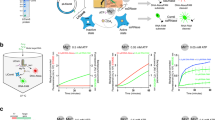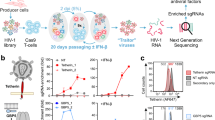Abstract
Recently, split intein-based detection sensors for RNA have been developed that can target custom sequences in a modular fashion. If multi-region, multi-sample sequencing were to be applied to a patient’s cancer, truncal (that is, earliest-occurring) mutations could be identified and could serve as targets for these sense-and-respond modules. The next step would be to utilize an effective vector for treatment. A hyper-virulent herpes simplex virus could possibly serve as this vector, with concurrent immunosuppression to allow for unhindered infection of the tumor regions. Given that, the oncogenic mutations could serve as molecular ‘kindling’, with exogenous small molecule-mediated enhancement of replication after initial seeding of tumors and metastases. Then, a toxin may be induced to destroy the cancer entirely, ideally with a bystander effect.
This is a preview of subscription content, access via your institution
Access options
Subscribe to this journal
Receive 12 print issues and online access
$259.00 per year
only $21.58 per issue
Buy this article
- Purchase on Springer Link
- Instant access to full article PDF
Prices may be subject to local taxes which are calculated during checkout



Similar content being viewed by others
Change history
07 January 2021
A Correction to this paper has been published: https://doi.org/10.1038/s41434-020-00216-8
References
Adamala KP, Martin-Alarcon DA, Boyden ES . Programmable RNA-binding protein composed of repeats of a single modular unit. Proc Natl Acad Sci USA 2016; 113: E2579–E2588.
Gerlinger M, Rowan AJ, Horswell S, Larkin J, Endesfelder D, Gronroos E et al. Intratumor heterogeneity and branched evolution revealed by multiregion sequencing. New Engl J Med 2012; 366: 883–892.
Kapust RB, Tözsér J, Fox JD, Anderson DE, Cherry S, Copeland TD et al. Tobacco etch virus protease: mechanism of autolysis and rational design of stable mutants with wild-type catalytic proficiency. Protein Eng 2001; 14: 993–1000.
Lonzarić J, Lebar T, Majerle A, Manček-Keber M, Jerala R . Locked and proteolysis-based transcription activator-like effector (TALE) regulation. Nucleic Acids Res 2016; 44: 1471–1481.
Shekhawat SS, Porter JR, Sriprasad A, Ghosh I . An autoinhibited coiled-coil design strategy for split-protein protease sensors. J Am Chem Soc 2009; 131: 15284–15290.
Vora S, Tuttle M, Cheng J, Church G . Next stop for the CRISPR revolution: RNA-guided epigenetic regulators. FEBS J 2016; 283: 3181–3193.
Esvelt KM, Carlson JC, Liu DR . A system for the continuous directed evolution of biomolecules. Nature 2011; 472: 499–503.
Carlson JC, Badran AH, Guggiana-Nilo DA, Liu DR . Negative selection and stringency modulation in phage-assisted continuous evolution. Nat Chem Biol 2014; 10: 216–222.
Ostermeier M . Engineering allosteric protein switches by domain insertion. Protein Eng Des Sel 2005; 18: 359–364.
Anders C, Niewoehner O, Duerst A, Jinek M . Structural basis of PAM-dependent target DNA recognition by the Cas9 endonuclease. Nature 2014; 513: 569–573.
Hillenbrand M, Shoulders M, Berman C A Platform for the Continuous Directed Evolution of Biomolecules in Human Cells. Online Report: http://web.mit.edu/rsi/2014/all/chillenb.pdf.gz (2014).
Wong SG, Dessen A . Structure of a bacterial α2-macroglobulin reveals mimicry of eukaryotic innate immunity. Nat Commun 2014; 5: 4917.
Thomas MA, Spencer JF, Toth K, Sagartz JE, Phillips NJ, Wold WS . Immunosuppression enhances oncolytic adenovirus replication and antitumor efficacy in the Syrian Hamster Model. Mol Ther 2008; 16: 1665–1673.
Simpson GR, Horvath A, Annels NE, Pencavel T, Metcalf S, Seth R et al. Combination of a fusogenic glycoprotein, pro-drug activation and oncolytic HSV as an intravesical therapy for superficial bladder cancer. Br J Cancer 2012; 106: 496–507.
Cronin M, Le Boeuf F, Murphy C, Roy DG, Falls T, Bell JC et al. Bacterial-mediated knockdown of tumor resistance to an oncolytic virus enhances therapy. Mol Ther 2014; 22: 1188–1197.
Wang W-D, Chen Z-T, Kang B-G, Li R . Construction of an artificial intercellular communication network using the nitric oxide signaling elements in mammalian cells. Exp Cell Res 2008; 314: 699–706.
Bacchus W, Lang M, El-Baba MD, Weber W, Stelling J, Fussenegger M . Synthetic two-way communication between mammalian cells. Nat Biotechnol 2012; 30: 991–996.
Dow LE, Fisher J, O’Rourke KP, Muley A, Kastenhuber ER, Livshits G et al. Inducible in vivo genome editing with CRISPR/Cas9. Nat Biotechnol 2015; 33: 390–394.
Yaghoubi SS, Gambhir SS . PET imaging of herpes simplex virus type 1 thymidine kinase (HSV1-tk) or mutant HSV1-sr39tk reporter gene expression in mice and humans using [18F]FHBG. Nat Protoc 2006; 1: 3069–3075.
Liu KI, Ramli MNB, Woo CWA, Wang Y, Zhao T, Zhang X et al. A chemical-inducible CRISPR-Cas9 system for rapid control of genome editing. Nat Chem Biol 2016; 12: 980–987.
Davis KM, Pattanayak V, Thompson DB, Zuris JA, Liu DR . Small molecule-triggered Cas9 protein with improved genome-editing specificity. Nat Chem Biol 2015; 11: 316–318.
Balzarini J, Ostrowski T, Goslinski T, De Clercq E, Golankiewicz B . Pronounced cytostatic activity and bystander effect of a novel series of fluorescent tricyclic acyclovir and ganciclovir derivatives in herpes simplex virus thymidine kinase gene-transduced tumor cell lines. Gene Ther 2002; 9: 1173–1182.
Katz SC, Point GR, Cunetta M, Thorn M, Guha P, Espat NJ et al. Regional CAR-T cell infusions for peritoneal carcinomatosis are superior to systemic delivery. Cancer Gene Ther 2016; 23: 142–148.
Smith TT, Moffett HF, Stephan SB, Opel CF, Dumigan AG, Jiang X et al. Biopolymers codelivering engineered T cells and STING agonists can eliminate heterogeneous tumors. J Clin Invest 2017; 127: 2176–2191.
Author information
Authors and Affiliations
Corresponding author
Ethics declarations
Competing interests
The author declares no conflict of interest.
Rights and permissions
About this article
Cite this article
Renteln, M. Conditional replication of oncolytic viruses based on detection of oncogenic mRNA. Gene Ther 25, 1–3 (2018). https://doi.org/10.1038/gt.2017.99
Received:
Revised:
Accepted:
Published:
Issue Date:
DOI: https://doi.org/10.1038/gt.2017.99



